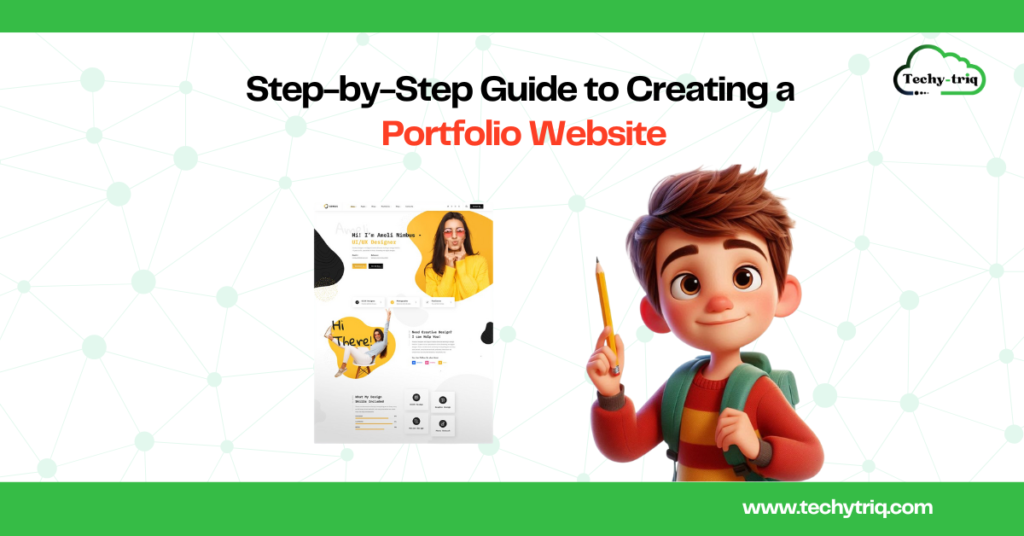In today’s competitive digital world, having a portfolio website is essential. Whether you’re a designer, developer, writer, or any professional, showcasing your work online increases visibility and credibility. his guide will walk you through the steps to create a stunning, professional portfolio website that stands out.
What Is a Portfolio Website and Why Is It Important?
A portfolio website is a personal digital showcase of your skills, projects, and professional journey. Unlike social media profiles or LinkedIn pages, a portfolio website gives you complete control over your brand’s presentation and content.
Key Reasons to Have a Portfolio Website
- Showcase Your Best Work: Highlight your expertise and creativity through well-curated projects.
- Create Opportunities: A great portfolio attracts clients, employers, and collaborators.
- Stand Out: A personalized site helps you differentiate yourself in a competitive job market.
- Build Authority: A professional website establishes you as a serious and capable individual in your industry.
Step 1: Define Your Purpose and Audience
Your portfolio should align with your career goals. Knowing your target audience helps you tailor the content and design.

Questions to Clarify Your Goals:
- Purpose: Are you creating this portfolio to land clients, secure a job, or establish an online presence?
- Audience: Who will visit your site? Hiring managers, potential clients, or collaborators?
- Focus: Which skills or projects best reflect your expertise?
For instance, a graphic designer might focus on a visually appealing layout, while a software developer might prioritize technical depth.
Step 2: Choose the Right Platform
Choosing the right platform is important for functionality and scalability.

Platform Options for Every Skill Level:
- Beginners:
- Wix: Easy-to-use drag-and-drop builder with customizable templates.
- Squarespace: Elegant designs with integrated blogging and e-commerce options.
- Intermediate Users:
- WordPress.org: Open-source and highly flexible, suitable for scaling your website.
- Weebly: User-friendly, great for showcasing portfolios with multimedia content.
- Developers:
- GitHub Pages: Code your website and host it for free.
- Netlify: Ideal for deploying custom-coded projects.
Step 3: Secure a Domain Name and Hosting
A professional domain name is your online identity. Keep it simple, relevant, and reflective of your brand.

How to Choose a Domain Name:
- Use your name if available: JaneLuizPortfolio.com.
- Combine your profession: JaneLuizWrites.com.
- Keep it short and memorable.
Recommended Domain Providers:
- Sav: https://www.sav.com/
Recommended Hosting Providers:
- Hostinger: Budget-friendly with fast loading speeds.
(Get Hostinger 85% off + 3 months FREE through this Link ) - Bluehost: Affordable and beginner-friendly.
- SiteGround: Known for excellent customer support.
Step 4: Plan Your Website Layout
A well-structured layout ensures visitors find what they need quickly.

Essential Sections to Include:
- Home: A clean and inviting introduction. Use a compelling headline and a call-to-action (CTA).
- About: Share your journey, skills, and what makes you unique.
- Portfolio/Projects: Showcase your best work with detailed descriptions, images, or videos.
- Testimonials: Add social proof through client or colleague endorsements.
- Contact: Provide a form, email, or links to connect easily.
Optional Sections:
- Blog: Share insights, case studies, or your learning journey.
- Services: List offerings if you’re freelancing or consulting.
Step 5: Craft a Professional Design
Design is the first thing visitors notice. It should reflect your style while maintaining professionalism.

Design Tips for Beginners:
- Minimalism: Avoid clutter; focus on clean, organized layouts.
- Colors: Use 2-3 colors that resonate with your personal brand. Tools like Coolors can help.
- Fonts: Stick to readable fonts like Roboto, Open Sans, or Helvetica.
Advanced Design Tools:
- Figma or Adobe XD: Create and test website prototypes.
- Canva: Design banners, social media links, and portfolio graphics.
Step 6: Optimize Your Content
Your content should engage visitors and guide them to take action, such as contacting you or viewing more projects.

Content Guidelines:
- Use high-quality visuals for your portfolio pieces.
- Write clear, concise descriptions for your work.
- Focus on achievements and outcomes, not just tasks.
- Incorporate keywords for better SEO, e.g., “graphic design portfolio” or “React developer showcase.”
Step 7: Ensure Mobile Responsiveness
With over 60% of traffic coming from mobile devices, your website must work seamlessly on any screen size.

Tools for Testing Responsiveness:
- Google’s Mobile-Friendly Test
- Browser developer tools to simulate various devices.
Step 8: Optimize for SEO
SEO (Search Engine Optimization) ensures that your website is visible on search engines like Google.

Actionable SEO Tips:
- Keyword Research: Use tools like Google Keyword Planner or Ubersuggest to find relevant keywords.
- Meta Tags: Write compelling meta titles and descriptions for each page.
- Alt Text: Describe every image using alt tags to make it accessible and SEO-friendly.
- Page Speed: Compress images and minimize code using tools like TinyPNG and Google PageSpeed Insights.
Step 9: Test Your Website Thoroughly
Before launching, test everything to ensure your website is error-free.

Testing Checklist:
- Check for broken links.
- Ensure buttons, forms, and contact links work.
- Test on multiple browsers (Chrome, Firefox, Safari) and devices (mobile, tablet, desktop).
Step 10: Launch and Promote Your Portfolio
Once everything is in place, it’s time to go live! After launching, promote your website to gain traffic and visibility.

Promotion Tips:
- Add your portfolio link to your email signature.
- Share your website on LinkedIn, Twitter, and other platforms.
- Engage in industry forums and include your link in discussions.
- Ask for feedback from peers and mentors to refine the website further.
Maintaining and Updating Your Portfolio
A portfolio is a living document. Regularly update it with new projects, achievements, or skills.
Ideas for Maintenance:
- Add blog posts or case studies to showcase ongoing learning.
- Include testimonials or endorsements from recent clients.
- Update the design periodically to stay fresh and modern
Conclusion
Creating a portfolio website is an investment in your future. By following these steps, you can build a site that highlights your talent, enhances your credibility, and helps you achieve your career goals.
Start building today, and take that first step toward showcasing your skills to the world!



